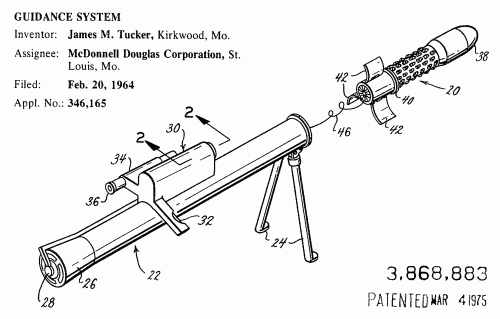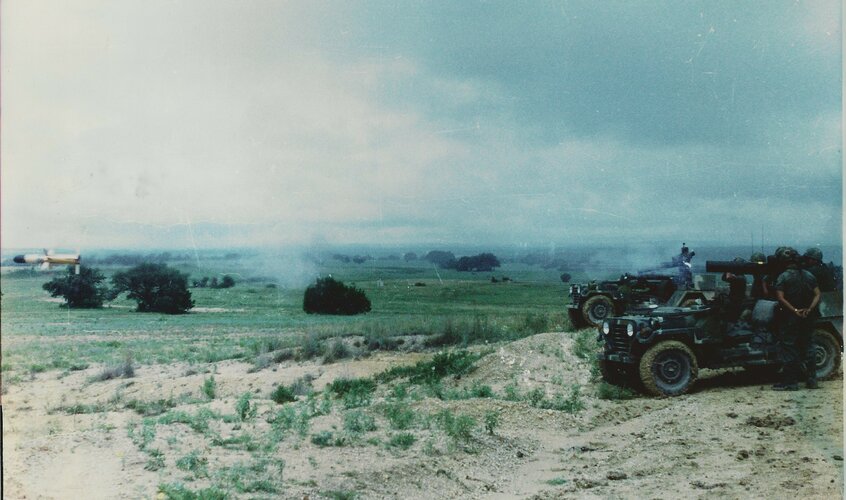- Joined
- 25 June 2009
- Messages
- 13,751
- Reaction score
- 2,943
In 1959, the U.S. Army Ordnance Missile Command (AOMC) suggested the development of a medium-range heavy assault weapon. The Office, Chief of Research and Development indicated that no firm requirement existed for the weapon. In February, McDonnell Douglas Corporation began work on the BRAT anti-target weapon system, developed as both a short-range, man-transportable ground based launching system and a vehicle-mounted recoiless rifle launching system. Designated as Model 146A Sidekick, the BRAT was a single-stage missile with no moving parts. The system required a minimum amount of operator skill and training and relied on a unique guidance system based on the ability to detect the boundary between background radiation and radiation from the projector.
The Sidekick system's main features were:
As of September 1961, McDonnell started development of the Model 146B Sidekick II variant. It differed from the initial model in that the launch was done optically (tracked with a fixed reticle, V-shaped pattern) and only from a tube. Command signals were generated and transmitted to the missile with a wire guidance link, which resulted in the firing of individual sidethrusting cartridges in the missile. By 1962, McDonnell had successfully developed, built, and tested the system, now designated the Tow Sidekick antitank missile. The flight sequence of the Sidekick was done in two phases: first an unguided boost phase, followed by a guided flight phase after motor burnout.
Army requirements, however, were evolving fast. On March 8, he Continental Army Command (CONARC) issued developer guidance for a manportable, shoulder-fired medium antitank/assault weapon system. Then on May 15, the Office, Chief of Ordnance (OCO) issued the Medium Antitank/Assault Weapon (MAW) directive which assigned overall project responsibility to the Ballistic Research Laboratory (BRL). In October, the BRL released a qualitative development requirements information (QDRI) document on the MAW, and the next month solicited industrial proposals for the MAW concept.
Nineteen companies responded, including McDonnell, which proposed a scaled down version of the Tow Sidekick utilizing similar guidance logic, the Model 189, whose development started in September 1963. Subsequently, James M. Tucker, a McDonnell employee, conceived a new type of guidance system for the MAW missile.
This new guidance system and the scaled down version of the Tow Sidekick missile were the subject of Patent Application Serial Number 346,165 (the Tucker Patent Application) which was filed on February 20, 1964, and eventually matured into U.S. Patent No. 3,868,883 (the Tucker or '883 patent).
The patent had not yet been granted, however, when, on August 31, 1964, McDonnell entered into an experimental development contract, Contract No. DA-01-021-AMC-11350(Z) (the 11350(Z) contract), with the Army to develop such an MAW missile and demonstrate the feasibility of its command guidance concept of a 1,000-meter medium assault weapon. At the time the 11350(Z) contract was made, the new, smaller McDonnell missile had not been constructed or flight tested, although the guidance system and other subsystems had been tested by computer simulation. The physical tests proved that the computer approved device, designed to be launched by a person against a still or a moving target, failed in actual practice (in several significant circumstances) to perform in the manner intended. In short, the physical tests demonstrated that the computer-tested device might or might not work as it was supposed to do. However, McDonnell successfully completed the experimental development program under the 11350(Z) contract.
However, after the merger of McDonnell and Douglas, the competing design, developed by Raytheon Corporation and Kollsman Instrument Company, was assigned by the Army to the new McDonnell Douglas company and McDonnell's own Model 189 was no longer heard of. The BRL completed the evaluation of the QDRI proposals for the MAW and recommended that the McDonnell Douglas concept be studied further through an exploratory development contract. AMC directed MICOM to proceed with the McDonnell MAW and work with BRL on MICOM's own directional control (DC) concept. A MAW Project Office was established on April 1, 1965, and by September the Dual exploratory program (McDonnell Douglas and MICOM DC-MAW) was completed. On October 8 it was concluded that the McDonnell Douglas MAW was the concept which best met the technical requirements. On February 25, 1966, McDonnell Douglas was awarded an engineering development contract and eight days later, the Chief of Research and Development, DA, approved the development of the McDonnell Douglas MAW.
The McDonnell Douglas MAW, which had superseded McDonnell's own MAW design, became the famous mass-produced M-47 Dragon anti-tank missile. McDonnell later sued the government on the grounds that the final choice for the MAW system had not been fair to them, but they eventually lost.
Main sources:
The Sidekick system's main features were:
- IR detectors,
- a launching system with geared-down manual tracking system,
- a tri-pod launcher,
- a launch tube also used as a carrying case,
- an infrared projector,
- 10x telescopic sight,
- small spin rockets for missile control when fired from launching tube,
- a solid non-metallic propellant rocket motor.
As of September 1961, McDonnell started development of the Model 146B Sidekick II variant. It differed from the initial model in that the launch was done optically (tracked with a fixed reticle, V-shaped pattern) and only from a tube. Command signals were generated and transmitted to the missile with a wire guidance link, which resulted in the firing of individual sidethrusting cartridges in the missile. By 1962, McDonnell had successfully developed, built, and tested the system, now designated the Tow Sidekick antitank missile. The flight sequence of the Sidekick was done in two phases: first an unguided boost phase, followed by a guided flight phase after motor burnout.
Army requirements, however, were evolving fast. On March 8, he Continental Army Command (CONARC) issued developer guidance for a manportable, shoulder-fired medium antitank/assault weapon system. Then on May 15, the Office, Chief of Ordnance (OCO) issued the Medium Antitank/Assault Weapon (MAW) directive which assigned overall project responsibility to the Ballistic Research Laboratory (BRL). In October, the BRL released a qualitative development requirements information (QDRI) document on the MAW, and the next month solicited industrial proposals for the MAW concept.
Nineteen companies responded, including McDonnell, which proposed a scaled down version of the Tow Sidekick utilizing similar guidance logic, the Model 189, whose development started in September 1963. Subsequently, James M. Tucker, a McDonnell employee, conceived a new type of guidance system for the MAW missile.
This new guidance system and the scaled down version of the Tow Sidekick missile were the subject of Patent Application Serial Number 346,165 (the Tucker Patent Application) which was filed on February 20, 1964, and eventually matured into U.S. Patent No. 3,868,883 (the Tucker or '883 patent).
The patent had not yet been granted, however, when, on August 31, 1964, McDonnell entered into an experimental development contract, Contract No. DA-01-021-AMC-11350(Z) (the 11350(Z) contract), with the Army to develop such an MAW missile and demonstrate the feasibility of its command guidance concept of a 1,000-meter medium assault weapon. At the time the 11350(Z) contract was made, the new, smaller McDonnell missile had not been constructed or flight tested, although the guidance system and other subsystems had been tested by computer simulation. The physical tests proved that the computer approved device, designed to be launched by a person against a still or a moving target, failed in actual practice (in several significant circumstances) to perform in the manner intended. In short, the physical tests demonstrated that the computer-tested device might or might not work as it was supposed to do. However, McDonnell successfully completed the experimental development program under the 11350(Z) contract.
However, after the merger of McDonnell and Douglas, the competing design, developed by Raytheon Corporation and Kollsman Instrument Company, was assigned by the Army to the new McDonnell Douglas company and McDonnell's own Model 189 was no longer heard of. The BRL completed the evaluation of the QDRI proposals for the MAW and recommended that the McDonnell Douglas concept be studied further through an exploratory development contract. AMC directed MICOM to proceed with the McDonnell MAW and work with BRL on MICOM's own directional control (DC) concept. A MAW Project Office was established on April 1, 1965, and by September the Dual exploratory program (McDonnell Douglas and MICOM DC-MAW) was completed. On October 8 it was concluded that the McDonnell Douglas MAW was the concept which best met the technical requirements. On February 25, 1966, McDonnell Douglas was awarded an engineering development contract and eight days later, the Chief of Research and Development, DA, approved the development of the McDonnell Douglas MAW.
The McDonnell Douglas MAW, which had superseded McDonnell's own MAW design, became the famous mass-produced M-47 Dragon anti-tank missile. McDonnell later sued the government on the grounds that the final choice for the MAW system had not been fair to them, but they eventually lost.
Main sources:
- http://www.leagle.com/xmlResult.aspx?xmldoc=1982826670F2d156_1775.xml&docbase=CSLWAR1-1950-1985
- McDonnell reports 7008, 7573, 8031, 9724, B955, E036, E408, E505, E524
- The Dragon storyhttp://www.redstone.army.mil/history/systems/Dragon.html
- The Tucker guidance system: http://www.freepatentsonline.com/3868883.pdf
Attachments
Last edited by a moderator:


